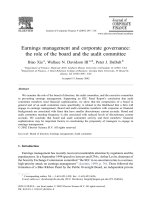aligning talent management and succession planning with business strategy comfori hr conference
Bạn đang xem bản rút gọn của tài liệu. Xem và tải ngay bản đầy đủ của tài liệu tại đây (257.75 KB, 32 trang )
ALIGNING TALENT MANAGEMTENT
AND SUCCESSION PLANNING WITH
BUSINESS STRATEGY
Case Study of CNI’s Journey
Kenny Ong
CNI Holdings Berhad
Contents:
A. Principles and Objectives
B. Attract and Identify
C.Strategy Examples
D.Issues and Challenges
E. Mistakes and Lessons
F. What’s Next?
G.For Starting Up…
About: CNI
1. 18 years old
2. Core Business: MLM
3. Others: Contract Manufacturing,
Export/Trading, eCommerce
4. Malaysia, Singapore, Brunei, Indonesia, India,
China, Hong Kong, Philippines, Italy, Taiwan
5. Staff force: ± 500
6. Distributors: 250,000
7. Products: Consumer Goods and Services
A. Principles and Objectives
Principles
1. Background
2. Needs
3. HR
A. Principles and Objectives
Principles
1. Background & Implications
1.Founders
2.Senior leaders
3.Dedication & commitment
4.Multi-racial, multi-cultural
5.Age, Gender not a barrier
6.Operational culture
7.Operations-intensive
8.Customers and policies
9.Vocal and demanding
10.Flexibility vs. Discipline
11.Systems run operations
12.Hierarchy and status
13.Ad-hoc
14.Project-based
15.Meetings
16.Empowerment
17.Do not dare consult
18.Young talents leaving
The Four Desperates
1. Desperate
Competition
2. Desperate
Consumer
3. Desperate
Achievers
4. Desperate
Changes
A. Principles and Objectives
Principles
2. Company’s Needs
1. Succession Planning of Key Leaders –
Founding Directors (perpetual business theory)
2. Retention of Key Staff – especially younger
ones
3. Transform into a Performance-based
organization
A. Principles and Objectives
Principles
3. HR Philosophy
1. Equal / Fair
2. Happy / Productive
3. Hire Low, Train High
4. Performance vs Potential
5. SP drives TM
6. Retention / Engagement
7. Talent Pool owned by the company
A. Principles and Objectives
Objectives of Talent
Management
1. Succession Planning
2. Retention of Key Staff
3. Performance-based organization
A. Principles and Objectives
CNI Model A: In theory…
A. Principles and Objectives
CNI Model B: More Practical…
P/P Grid, SP Table,
PDP, Premium,
Selection
P/P Grid, Q12,
PA, SDP, SP
Evaluation
Business
Strategy
Development
Motivation
Q12, C&B, ACDP, SCL,
Transfers, Events, Recognition
OJT, Mentoring,
Big-5, LP, PDP,
SDP, Projects,
A. Strategy First…
Corporate
Resources
Structure
Corporate
Strategy
Culture
Leadership
Person
Objective
A. Strategy First…
1. Balanced Scorecard
2. Market Disciplines
A. Strategy First…
Financial
Customers /
Distributors
Internal
Process
Learning &
Growth
Market Value
Revenue
Growth
Products/
Services
Channel
Strategies
Supplier &
Alliances
Department
Operations
Productivity
Target
Markets
External
Involvement
Technology
Human
Resources
Systems &
Processes
Information &
Intelligence
A. Strategy First…
Product Leadership
(best product)
Operational Excellence
(low cost producer)
Ref: The Discipline of Market Leaders, Michael Treacy & Fred Wiersema; 1995
Customer Intimacy
(best total solution)
B. Attract and Identify
• Identify
NonHOD
Decision?
1 year
Service
Finalized
by BOD
E1 and
above
Supported
by HOD
B. Attract and Identify
POTENTIAL
• Identify
5
(Talent Pool)
3
5
4
4
3
Group I
2
PERFORMANCE
2
B. Attract and Identify
POTENTIAL
• Identify
5
Group I
( Potential)
(Talent Pool)
Group IV
Group III
(Counseling)
( Performance)
5
Group II
4
4
3
3
2
PERFORMANCE
2
B1. Additional Categories
Definition of ‘Premium’ staff
1. Specially selected from the TP.
2. They have in addition, the
following attributes:
a. High-profile in the field or
industry
b. Loyalty proven
c. Proven high work-rate and
great attitude
d. Undeniable contribution
and efforts
e. Highly looked upon and
respected by most staff
f. Ability to multi-task and
assist in various areas
g. Key people in CNI’s
Succession Plans
Definition of ‘Specialist’ Staff
1. Has competencies (skills &
knowledge) in a particular
professional field of work.
2. A staff is deemed to be a
Specialist when all the
following occurs:
a. The particular
Competency (Skills or
Knowledge or both) is
highly required by CNI
b. Supply for the competency
in the market is low but
demand is high
c. The competency is difficult
to learn, transfer and/or
duplicate
B. Attract and Identify
• Attract
– CNI’s candidate attraction strategy is
not strong at this moment.
• Hiring
– Behavioral Event Interview
– Panel
– Telephone Interview
– Live Assessments
– Big 5 Psychometric Profile
C. Strategy Examples
CNI Model B: More Practical…
P/P Grid, SP Table,
PDP, Premium,
Selection
P/P Grid, Q12,
PA, SDP, SP
Evaluation
Business
Strategy
Development
Motivation
Q12, C&B, ACDP, SCL,
Transfers, Events, Recognition
OJT, Mentoring,
Big-5, LP, PDP,
SDP, Projects,
C1. Strategy: C&B
1.
2.
3.
4.
Eliminate Staff Awards
Eliminate Staff Trips
Eliminate HOD trips
Remove Salary structure
limitations for TP
5. Premium Group Pay
6. Year-round
promotions/increment
7. Spot Bonus Pool
8. Additional Profit Sharing
points for TP
9. ↑ Pay for Performers,
↓ pay for NonPerformers
10. Additional % during
annual increments
11. Special Allowances
12. SCL Allowances
13. Flexitime
D. Issues and Challenges
1. HODs unclear
2. HODs disagree/unsupportive of TM
3. HODs not committed to developing staff
4. Functional silos
5. HODs not willing to openly differentiate staff
6. Incompetent superiors/HODs to TP staff
7. Succession plan for specific positions is a
moving target
D. Issues and Challenges
8. Difficult to evaluate Performance
9. Difficult to evaluate Potential
10.Aligning TM and SP with Business Goals
11.To the Talent Pool, it is more work, no reward
12.Unsynchronized and unmonitored training and
development
13.Difficult for TP staff to allocate time for training
and development
14.“Once in, always in” predicament
E. Mistakes and Lessons
1. Succession Planning = business directions
2. CEO’s role
3. Separate HRM and TND departments
4. Measuring Potential is really difficult.
5. Two types of Talent: Leaders and Specialists
6. Openly announcing the Talent Pool - painful!
7. PDP group of rough diamonds
8. Split Leadership Development
9. Official annual ‘Event’
10.TM = Annual Performance Appraisal
Discussions









